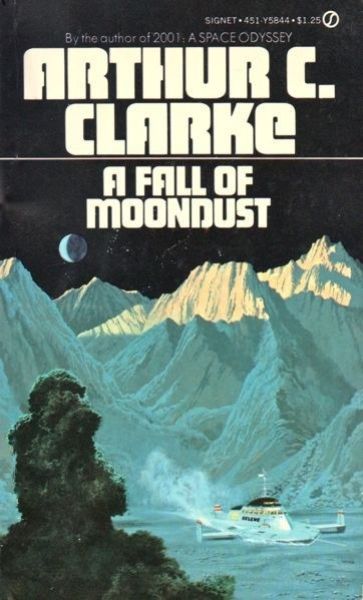Alive
A Fall of Moondust
By Arthur C. Clarke

11 Aug, 2024
Arthur C. Clarke’s 1961 A Fall of Moondust is a stand-alone near-future science fiction novel.
Just as the brilliant Thomas Gold predicted, the Lunar surface consists in part of a very fine dust, so fine as to act like a dry liquid. In the Sea of Thirst, a deep crater has accumulated a deep pool of dust. Ever keen on enhancing their income stream, the Lunar tourist board commissioned a specially designed vehicle, the Selene, to traverse the Sea of Thirst like a very odd boat.
Under Captain Pat Harris and stewardess Sue Wilkins, the Selene has toured the Sea of Thirst many times. As Selene sets out from Port Roris, there is no reason to think the current excursion will be different. Nevertheless, this is Selene’s final voyage.
Unbeknownst to the tourist board, a gas bubble has been slowly building under the Sea of Thirst, product of gases percolating up through the Lunar regolith. The bubble bursts as Selene passes overhead. Selene sinks into the Sea of Thirst, leaving no visible trace on the surface.
Selene is not crushed by the weight of the fifteen metres of dust above it. Furthermore, Selene has ample power and air for a week. The food reserves should last as long as the air does. There is even a reserve of one thousand cigarettes. What the Selene lacks is any way to extract itself from the dust or any means to contact Port Roris.
Fortuitously, Lunar safety systems do not require an active signal to trigger emergency procedures. As soon as Selene misses its automated radio check-in, computers alert humans that there is a problem. In a surprisingly short time, the Lunar authorities know something has happened to Selene. The effort to rescue Selene begins.
Rescue will not be simple. Selene’s location is only generally known, and some of the evidence points to the wrong location. Even if Selene is located, the nature of the dust means it cannot simply be dug out. The rescuers will have to invent and deploy entirely new techniques on the fly.
It’s best for the rescuers’ equanimity that they do not know the time limit under which they are operating is much closer than they know. Selene was not designed to function surrounded by insulating dust. Vital systems are breaking down… some of them rather quickly.
~oOo~
It’s a disappointing book when a reread fails to turn up some new aspect (or at least one forgotten in the decades since I read the book for the first time). There were only minor surprises here.
- Clarke references London, Ontario. How odd that he should know of it!
- Clarke’s future history diverges from recorded history in an interesting manner. The first Lunar landing appears to have occurred on “8 November 1967, when the fiftieth anniversary of the Russian Revolution had been so spectacularly celebrated.”
- Presumably, that means that the Russians were the first people to reach the Moon, rather than
Grand Fenwickthe United States of America. Presumably, this means Chief Designer Sergei Korolev did not die in 1966 and that certain technical decisions played out very differently. - There was a disapproving discussion of the near-extermination of the Aboriginal Australians, something I didn’t expect to encounter in a book set on the Moon, particularly one written in 19611.
- Something that should not have surprised me given Clarke’s interest in telecommunications is how modern that side of the novel was. The communications technology seemed too modern for a 1961 novel. I wondered if the book had been updated (because I am more comfortable with larger fonts these days, I reread this as a modern ebook), but when I checked my Disco-era paperback, I found that the text had not been changed. Clarke was the first to imagine satellites and future telecommunications featured prominently in his non-fiction essays.
A Fall of Moondust follows the standard plot structure for a disaster novel: a diverse cast of stereotypes faces an unexpected calamity. Within the grander plot there is a series of escalating crises, culminating in a race against time. What makes Moondust stand out, aside from the skill with which Clarke hits every required note, is that (as far as I know; correct me if I’m wrong) Moondust is one of the earlier examples of this sort of thing. He may have helped create the conventions.
I should also note that the plot reminded me of real-life near-disaster in space, Apollo 13. Moondust predated Apollo 13 by nine years.
Clarke is not generally known for his plots. In this case the constraints of a disaster novel force Clarke to provide a well-constructed plot. His characters are not especially deep, but they are sufficient for need2. Aside from an excessive fondness for foreshadowing, the prose is acceptable.
Unusually for a novel of this vintage, a female character, Sue is as highly trained as Pat (male), albeit in different fields. If one were to rewrite the novel, it wouldn’t be hard to revise the novel to suit modern mores3
Oddly, although A Fall of Moondust seems perfectly suited to dramatization, the only adaptation of which I am aware is the 1981 BBC 1 radio play.
A Fall of Moondust is available here (Amazon US), here (Amazon Canada), here (Amazon UK), here (Apple Books), here (Barnes & Noble), here (Chapters-Indigo), and here (Words Worth Books).
1: Indigenous Australians did not obtain equal voting rights at all levels of government in all states and territories until 1965 and state-sanctioned child theft continued after that. All of which is very roughly comparable to the Canadian situation.
2: But the romance doesn’t work. Of the love affair between Pat and Sue, less said the better.
3: A modern rewrite would feature different stereotyped characters and there would be no mention of Selene’s prodigious supply of cigarettes.
